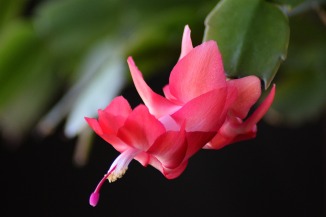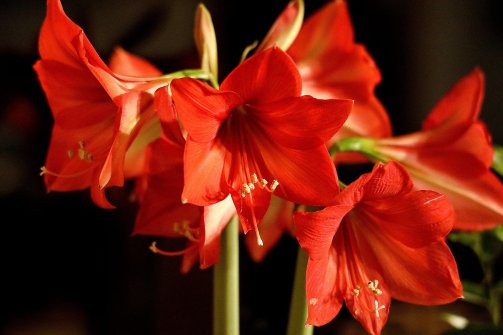Christmas cactus, amaryllis and poinsettias are popular gift plants during the holidays. They are beautiful, and fortunately, are not difficult to grow. Here are a few tips for each, to keep plants healthy until next Christmas, if you gave or received one this year.

Poinsettias
Many poinsettias hold their leaves and remain attractive after the holidays. At home place the poinsettia where it will receive maximum sunlight and cool night temperatures (60-65 degrees). Keep the plant away from very cold drafts and furnace vents that will dry the plant out quickly and possibly even scorch the leaves. The soil should remain evenly moist, but not soggy. About 2 weeks after receiving the plant, fertilize it with a complete fertilizer.
Depending on several cultural factors, your poinsettia will do one of two things after the holidays- hold onto its leaves or drop its leaves. If the plant holds its leaves, treat it like any houseplant. Leave it in a sunny location and apply a complete, water soluble, blooming-plant fertilizer once every two weeks.
If the plant loses its leaves, place it in a bright, cool location (50-55 degrees), such as on a basement window ledge, but avoid locations with temperatures above 60° F degrees. Let the soil dry out, but never let it get so dry that the stems start to shrivel. Allow the plant to rest in this condition until spring. In late April or early May cut back the stems to 3-5 inches from the soil and place it in a bright, warm location, watering whenever the soil dries out. New growth will begin to emerge. Pinch the new shoots back when they reach 4-6 inches in length to encourage bushiness. Plants can be grown on as a houseplant during summer or set outside when night temperatures stay above 60 degrees.
When outdoor night temperatures become cool, 55°F-60°F, bring the plant indoors to a sunny location. Before bringing it indoors, inspect the undersides of the leaves carefully for signs of insect pests, particularly whiteflies. If you do see signs of insects, get help from your local garden center on control before you bring the plant inside.
Poinsettias are influenced by day length to initiate blooming, specifically they need short days and long nights. Starting in late September poinsettias need complete darkness from 5 p.m. to 8 a.m. daily. Put a cardboard box, heavy paper bag or other device over the plant each day at 5 p.m. to provide the “long night” that is needed. Lights from any lamps will prevent normal flowering of an uncovered plant. Be sure the plant still gets plenty of light during the daytime hours.
Continue this “long night” treatment until the plant bracts show color in late November. Short days and 60-65°F night temperatures are essential for good bract development.

Christmas Cactus
If you received a Christmas cactus after the holidays, find a bright window without direct sun and apply a complete, water soluble, blooming-plant fertilizer once every two weeks. Water thoroughly when needed, but allow the top inch of soil to dry out between waterings. Leaf pad color is a good indicator of water needs; they will change from bright medium green to lighter color when plants get dry. Check the soil for moisture to be sure. Christmas cactus do better indoors than outside in summer, so once you find a window where it’s growing well, leave it there.
In fall, Christmas cactus often begin to initiate flower buds without much effort from the grower. Once days get shorter in fall, especially if night temperatures in your house are also cooler, flower buds will soon begin to form. Plants will be in full bloom in approximately 2 1/2 months.

Amaryllis
Often amaryllis sold as gift plants come already potted in a container, but if yours didn’t then choose a container that is only 1-2 inches wider than the bulb. The preferred soil mix for amaryllis is high in organic matter; a peat, perlite/vermicullite mixture would work well. Place the bulb in the container so that it is only halfway below the soil. Water it thoroughly, until water drips from the drainage holes. Allow the soil to dry, and rewater sparingly until the plant’s roots are well developed, and growth has begun. Overwatering can lead to bulb rots.
Place the plant in bright light, but not direct sun to lengthen flower life. Once growth begins, apply a complete fertilizer, either slow release or liquid. Water soluble fertilizer can be applied about twice a month. Consult the label on slow release products for the right amount and application timing.
Temperatures of 70 to 75° F are fine until the bulb begins to root, and leaves or flower stalks(s) begin to appear. Then move the plant to the coolest location possible in the house, where it will still have good light. Foliage is weakened by being forced too rapidly under higher temperatures. During bloom, cooler conditions will prolong the flowers.
Usually leaves appear first, followed by one or two flower stalks. Each stalk can have anywhere from 2 to 6 flowers each. Once the flower start to fade, pinch or cut them off. Remove the flower stalk by cutting it down to just above the bulb nose, once all the flowers are gone.
In August, begin withholding water and allow the foliage to die. Once the leaves are dried and brown, cut them off a couple inches above the top of the bulb. Place the plant, pot and all, in a cool (50-60°F degrees) dark place for 6 to 8 weeks. Bulbs can be kept in dormancy as needed to time their bloom for the holiday season.
After at least 6 to 8 weeks have passed, bring the plant out into a sunny location and begin watering it as normal. Amaryllis like to be a little pot bound, so they only need repotting every 2-3 years. A flower bud should appear in a few weeks.
Bulbs that had four or more healthy leaves throughout the summer should be large enough to flower; those with less foliage may not flower. However, with proper care non-flowering bulbs can be redeveloped for blooming in future years.
Images from Pixabay.

Leave a comment